Today’s article is quite interesting, want to know why? Well, have you ever heard that an animal is named after what it consumes?
The green sea turtle is named so, as it consumes plant-based food which gives them pigment. And that’s why their fat color is green which makes them a green sea turtle.
However, this green sea turtle diet includes a few more interesting things. Even their group has an exception which is the “East Pacific green sea turtle” as it consumes animals.
Other than these, I will cover every detail of what this exceptional sea turtle consumes. Let’s dig in deeper to get more insights about the green sea turtle food habits –
What Does a Green Sea Turtle Eat? (Reference)
You will be amazed to hear that a green sea turtle’s eating habits are different from any other sea turtle creature. Green sea turtles are herbivores. Whereas the other ones are carnivorous or omnivorous.
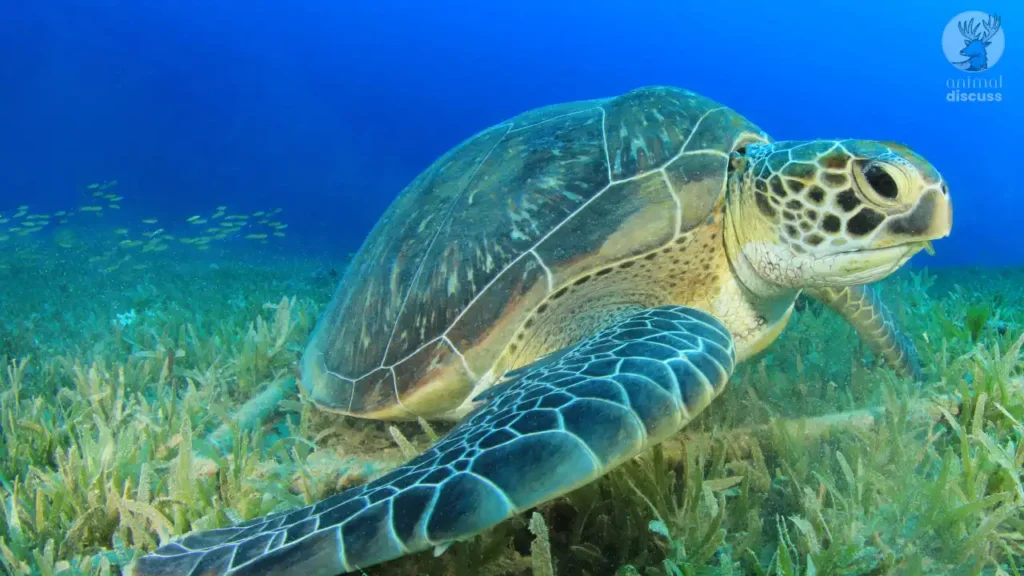
Because of being herbivores, their diet primarily depends on plants. Such as –
- Seagrasses – For adult green sea turtles, the underwater meadows are the energy pack. As it contains so many essential nutrients that complete their diet.
- Algae – Other than seagrasses, they eat algae too. Different types of algae are consumed by them such as red and green algae. Or the sea lettuce, crinkled grass, etc. are consumed by them.
Curious about Green Sea Turtle? Check out this article to learn more.
What Do Young Green Sea Turtles Eat? (Reference)
Well, not just they have an exception among the adult green sea turtles. But also, they have a distinction between the young ones too. As the young green sea turtles are mostly omnivores, they have both plants and animals, such as
- Mollusks like clams and mussels
- Fish eggs
- Worms
- Jellyfish
- Bryozoans
- Sponges
- Algae etc.
What Kind of Seagrass and Algae Green Sea Turtles Eat? (Reference)
Now that you already know what these sea creatures eat, you must be wondering what kind of seagrass and algae they eat. Well, I am here to introduce that too for you.
Beginning with the first one which is turtle grass (Thalassia testudinum). Both in tropical and subtropical waters, this kind of seagrass is present in huge quantities. You can say that it’s their favorite one. As it is rich in nutrition and easy to digest.
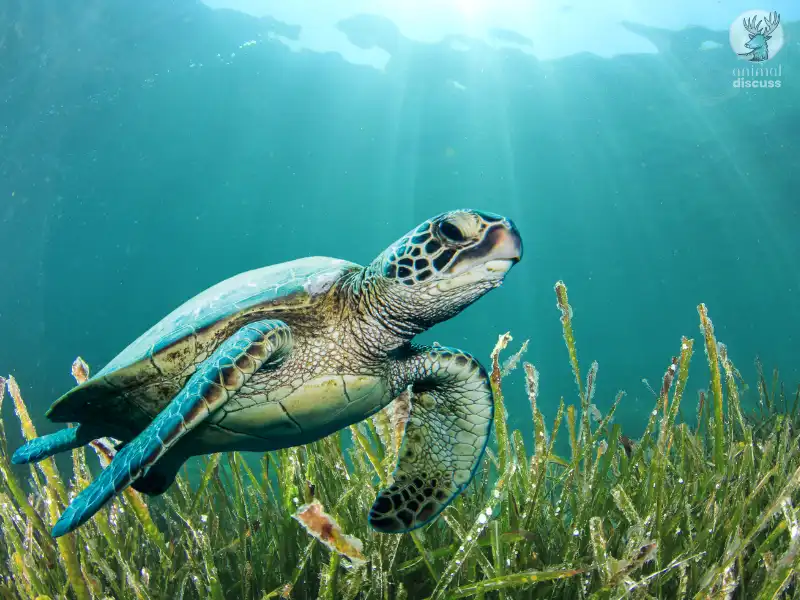
Another one is Manatee grass (Syringodium filiforme). This seagrass is quite common. Mostly it’s long, has slender blades, and is seen in areas where the waters are coastal shallow.
The third one is widgeon grass (Ruppia maritima). You can see this kind of seagrass both in salt and freshwater environments.
Moving on to the algae section. They eat green algae which we also know as chlorophyta.
Different types of green algae are taken by them like Caulerpa, Halimeda, and Enteromorpha. Both vitamins and minerals are assured through eating them.
Besides eating green algae, they consume red algae (Rhodophyta). Like Laurencia, Hypnea is red algae that is consumed through them. Because of the presence of pigments like carotenoids, it gives them a green color too.
What Is Green Sea Turtle Secondary Food Options? (Reference)
Other than the foods we have mentioned beforehand, they rely on sea lettuce and sponges as their secondary food options. Here’s a breakdown –
- When there is a scarcity of food, adult green sea turtles eat them. But lettuce and sponges have comparatively lower nutritional benefits than the other foods they consume.
- Moreover, the younger ones opportunistically consume this sea lettuce when they are unable to find something else. Unfortunately, adult green sea turtles cannot consume sponges. Because their digestive system doesn’t allow them to digest the hardy and spiny textures of sponges.
- But in the case of younger ones, they can sometimes include it in their diet. This is why green sea turtles occasionally consume sea lettuce and sponges. However, these items are not normally part of their diet as adults.
How Do Green Sea Turtles Acquire Their Food?
Beginning with adult ones, as they are herbivores naturally, there are no hunting or capturing prey scenarios noticed for this turtle. But they do have some methods which let them acquire the required food for themselves.
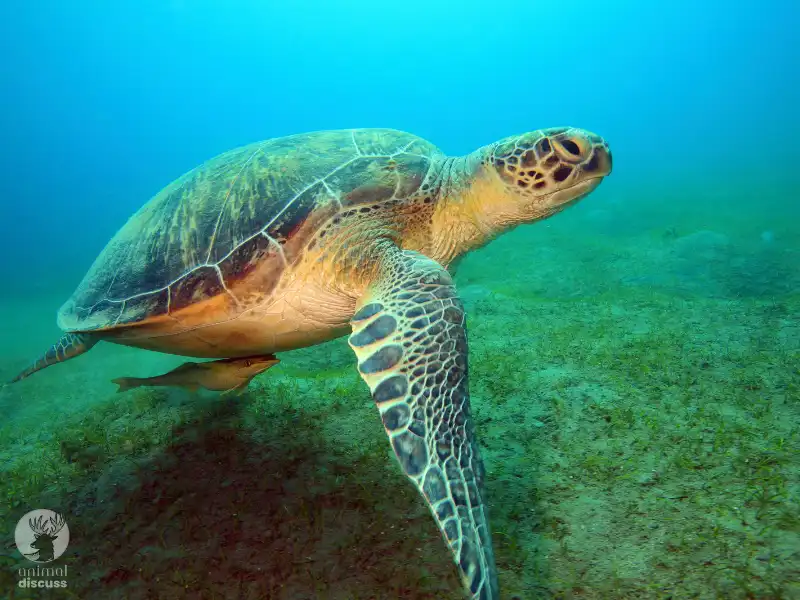
Here’s how they acquire their food-
Adult green sea turtles
Beginning with an adult green sea turtle selecting Seagrass. They graze in the seagrass meadows through their powerful, serrated jaws. Just like cattle grazing on land, a green sea turtle does a similar kind of thing.
Because of the serrated beaks, they are able to tear and rip through the tough seagrass blades.
Other than that, they browse algae too. They can snout and their front flippers allow them to explore and search for it. But they choose daylight for searching. The adult ones are mostly seen foraging for their food during the daytime.
Just using their powerful tongues, they can suck up algae or any other small food particles.
Young green sea turtles
The younger ones are different. Around the seafloor or the surface areas, they scavenge for dead or animals that are dying.
They can even be called opportunistic feeders. As they are young, they look for readily available food. Foods like jellyfish are small invertebrates that they can easily find while swimming.
What Way Do Green Sea Turtles Mitigate Their Hydration? (Reference)
Just like any other sea turtles, green sea turtles don’t literally drink water. Living in saltwater necessitates a supply of water for them.
This is how they manage the amount of water in their bodies:
Two kinds of salt glands are located close to the eyes of green sea turtles. Their scientific name is salt glands. These glands play a crucial role in eliminating excess salt from saltwater that they consume.
By excreting excess salt, green sea turtles are able to maintain a healthy fluid and salt balance in their body. This prevents them from losing too much water weight.
In this way, they can prolong the life of the freshwater in their meal and reduce their use of saltwater. And that’s how they mitigate their hydration demands.
How the Environmental Factors Help Green Sea Turtles to Pick Their Food?
As they are natural creatures, all they need is a few supports which they grab from several environmental factors. In order to find their primary foods like seagrasses, and algae, they need to detect it. And they can navigate towards their food easily and efficiently through clearer water.
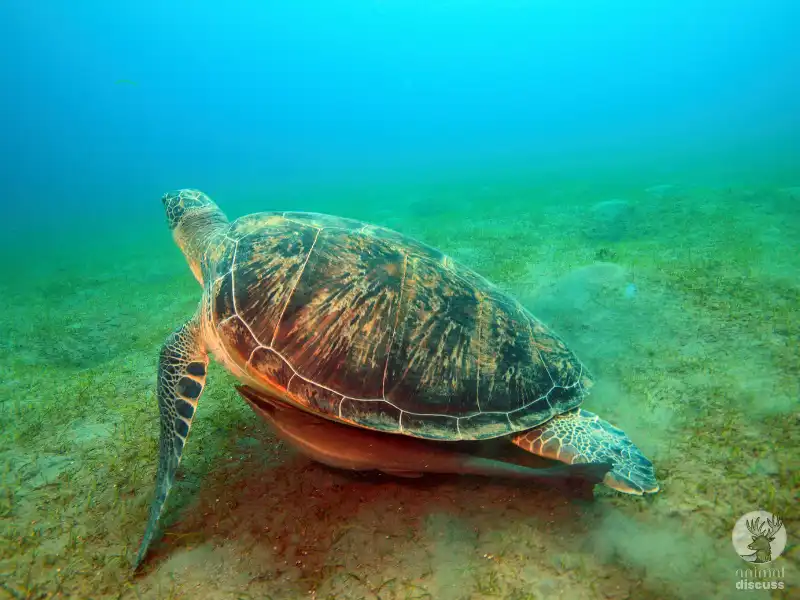
However, seagrass meadows are significantly impacted due to tide cycles. So, during low tides, they are exposed, and it gets easier to access and graze them.
Likewise, green sea turtles are able to carry themselves to areas where there are bulk amounts of food sources through currents. Even it brings them food particles sometimes which decreases their chance of searching for food.
When the temperature is warmer, it increases the growth and distribution of their foods. As a result, it influences their availability of food. Do you know when the salinity level is optimal, seagrass production increases? That gives them a chance to have a good amount of food.
On the other hand, their food not only gives them nutrition, but it also gives them camouflage and shelter when needed. So, whenever they see any predators, it keeps them safe too. Thus, reefs and mangroves give them safety and protection too.
Seasonal Availability Of Food For Green Sea Turtle
Food for green sea turtles depends on numerous factors. And one of them is the seasonal availability of those too. Before going on to that, we need to keep in mind their location too.
The production of these seagrass and algae fluctuates when there is a change of season. As in warmer temperatures increasing sunlight in summer assures the growth of these plants.
Whereas, in winter months, when the temperature is low and there is less sunlight, production rapidly decreases. So, their food scarcity can be noticed at that time. But the exception relies upon the East Pacific green sea turtles. When there are seasonal variations, they tend to consume more animal prey.
That’s why they can alternate and go to food jellyfish populations when a certain season has other food scarcity.
How Do Green Sea Turtles Adapt to The Seasons with Lack of Food?
When there is a seasonal lack of food, they need several remarkable adaptations. That’s what we are going to uncover now –
One of the key strategies for them to adapt is migrating here and there. When there are seasonal food sources scarcity, they migrate long-distance. It is recorded that the longest distance they have covered so far is 1,615 miles from their nesting to their feeding ground.
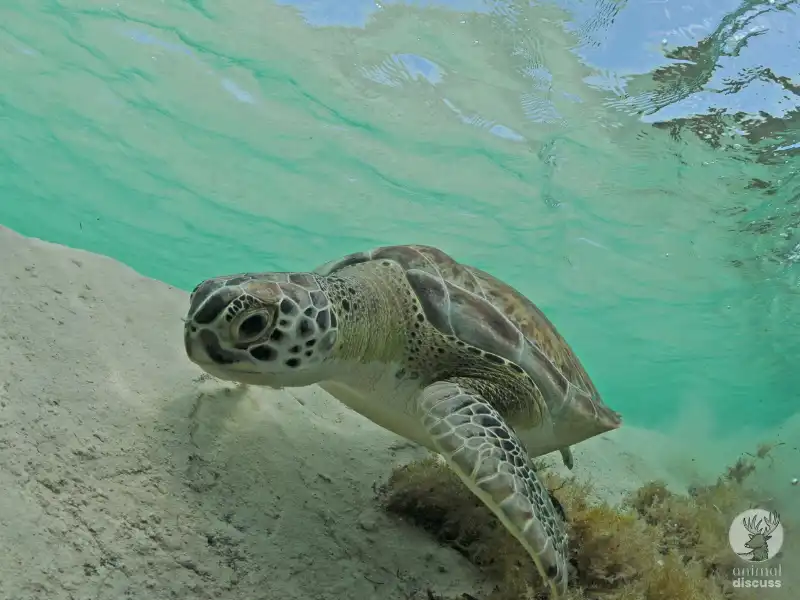
But the fun part is for the younger ones. The diet of younger green sea turtles is flexible as they are omnivores. In order to adapt to the seasonal scarcity, they go for animal-based food. They consume jellyfish, crustaceans, etc.
Just like any other animal, this green sea turtle has grown in an efficient way to store their energy in the form of fat. When abundant food is present, through increasing their reserve amount they save themselves in scarcity.
And one common way to save energy is to deduct the overall activity level. They minimize the need for food intake and are able to conserve energy, such as by resting or swimming slowly they try to reduce their energy expenditure.
Consequently, through an efficient digestive system, green sea turtles are able to gain maximum levels of nutrients through what they consume. So, while food is scarce, it gives them a good backup of nutritional value.
Well, few green sea turtles exhibit behavioral adaptations in order to cope with the lack of food. For instance, they forage into deeper waters where the availability of food is balanced throughout the year.
Frequently Asked Questions
Now, let’s look at a few common questionnaires to resolve your most-asked questions –
01. How much does a green sea turtle consume in a day?
Well, depending on the age, activity level, size, and season, the consumption of food varies for them. But according to their body weight, they consume from 2% to 7% of seagrass on a regular basis.
02. How long can a green sea turtle go without food?
Adult green sea turtles, if they are healthy, can survive 8 to 10 days without eating. They have an efficient digestive system and can store fat for energy, so they obtain the maximum nutrients from the food they eat.
03. How many calories does a green sea turtle eat in a day?
Green sea turtles need between 100 and 150 calories per kilogram of body weight daily.
Conclusion
Well, while talking about green sea turtle eating habits we have reached almost the end of today’s discussion. Though their eating habits have less diversity, it’s full of selective and precise decisions about what they consume.
Let’s be more cautious about them and not dump plastic bags. As they can consume it thinking of it as a jellyfish. Because the younger ones’ diet includes jellyfish. Hope you’ve enjoyed the article.

